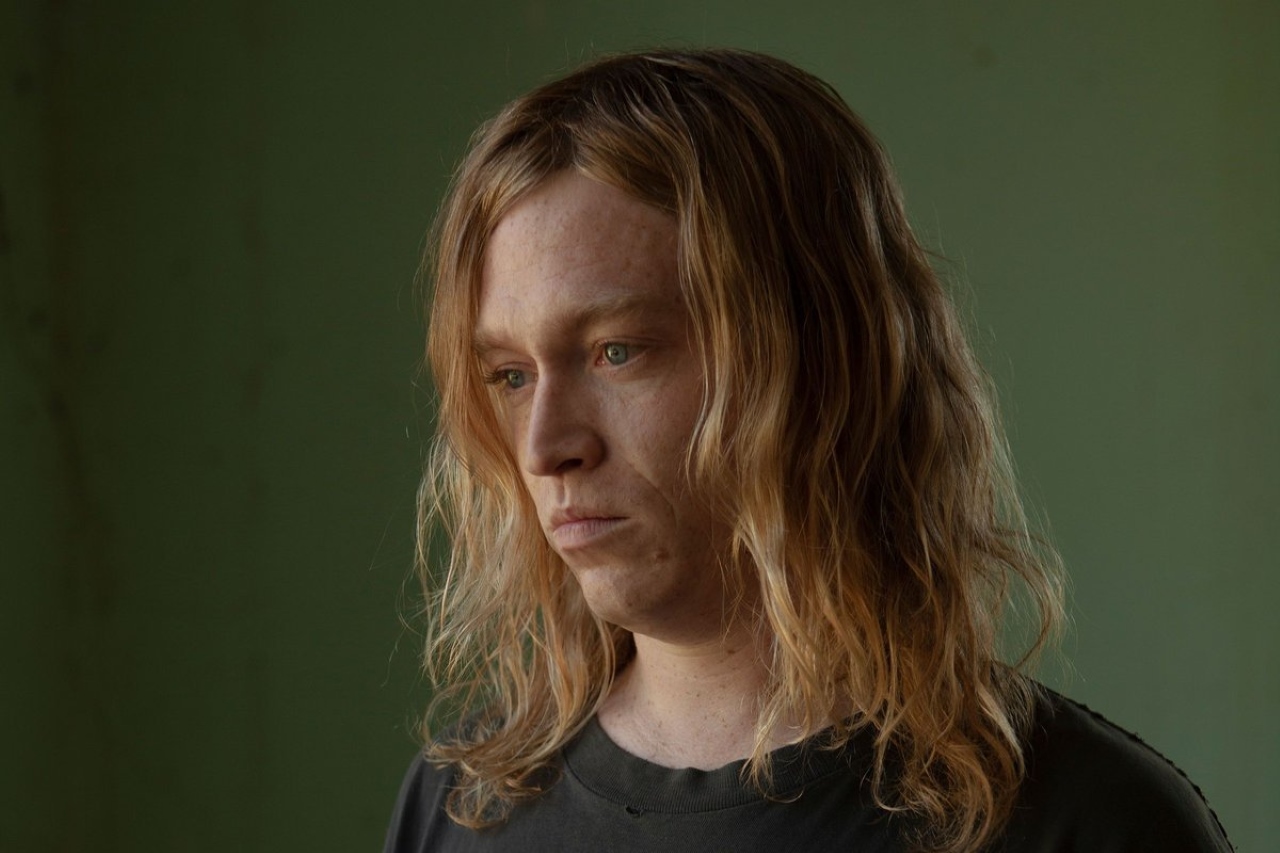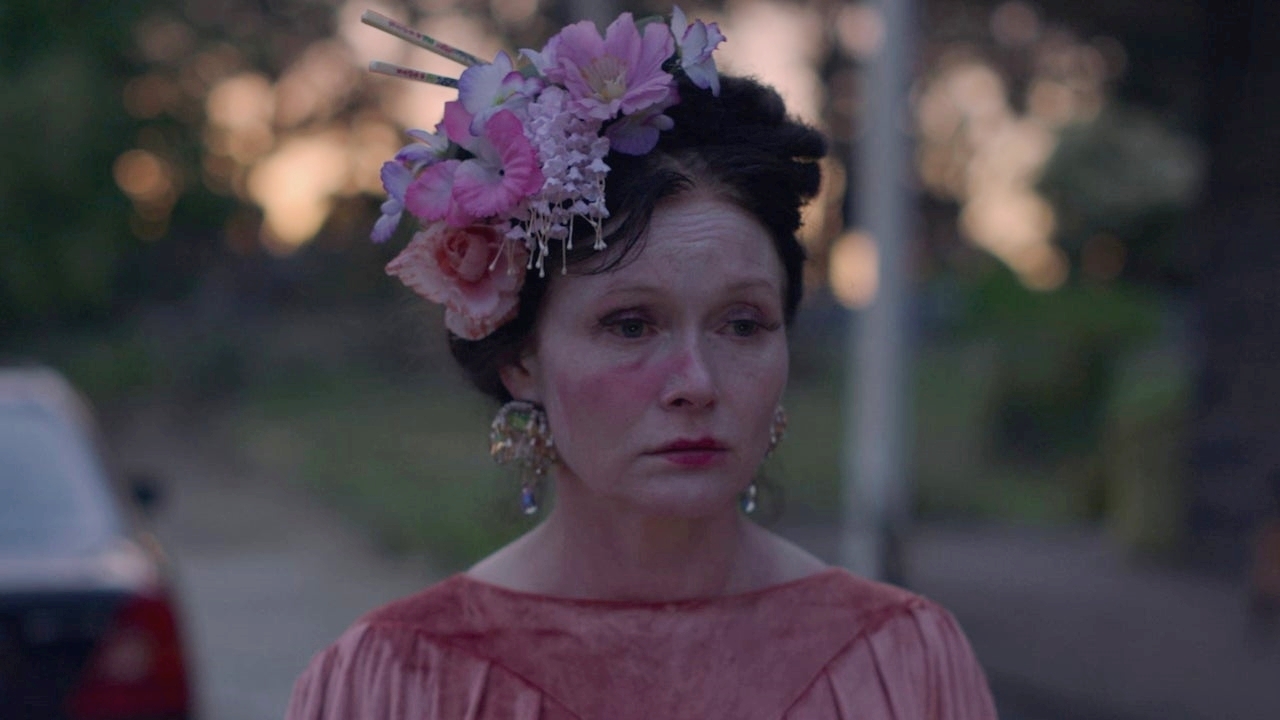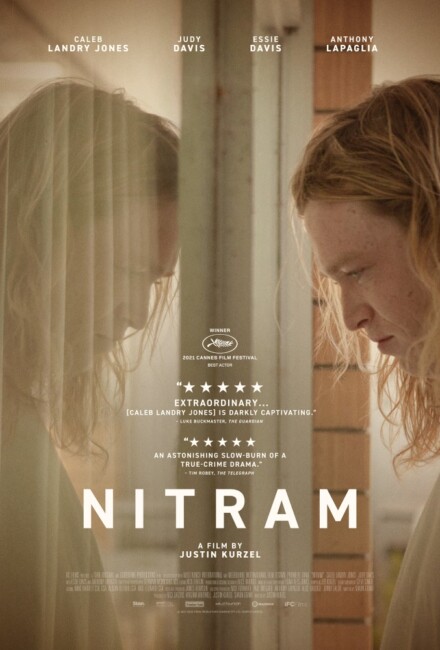Australia. 2021.
Crew
Director – Justin Kurzel, Screenplay – Shaun Grant, Producers – Nick Batzias, Shaun Grant, Justin Kurzel & Virginia Whitwell, Photography – Germain McMicking, Music – Jed Kurzel, Special Effects – Show FX (Supervisor – Allan Spiegel), Production Design – Alice Babidge. Production Company – Goodthing Productions/Wild Bunch International/Melbourne International Film Festival Premiere Fund.
Cast
Caleb Landry Jones (Nitram), Judy Davis (Mum), Anthony LaPaglia (Dad), Essie Davis (Helen), Sean Keenan (Jamie), Lucas Friend (Salesman), Conrad Brandt (Doctor), Anita Jenkins (Travel Agent), Rick James (Gun Shop Owner)
Plot
Tasmania, Australia, the late 1980s. Nitram lives with his parents and has an intellectual disability. He makes side money with his lawn mowing service. After going to mow the lawns of wealthy heiress Helen, he is hired by her as a walker for her dozens of dogs. The two quickly become friends and, following an argument with his parents, Nitram moves in with Helen. However, Nitram has the habit of grabbing the wheel of Helen’s car while she is driving and causes them to crash, killing Helen. In her will, Helen leaves Nitram her house and fortune. Nitram’s father was banking all his hopes on buying a house that he could turn into a B&B, but this is sold to others for a higher asking price. Deeply depressed, Nitram’s father kills himself. In the aftermath, Nitram begins to buy up guns.
Australian director Justin Kurzel first appeared with the electrifying Snowtown (2011) based on a series of true-life killings in Adelaide in the 1990s where victims were left in barrels in a bank vault. Kurzel subsequently went on to make an adaptation of MacBeth (2015), the videogame adaptation Assassin’s Creed (2016) and further true crime films with the acclaimed True History of the Kelly Gang (2019), followed by Nitram here and the subsequent The Order (2024).
Nitram is based on the story of Martin Bryant, the greatest mass murderer in Australian history. Born in 1967, Bryant grew up in Tasmania where he was considered as having a social/intellectual disability (although diagnoses differ as to what). In 1987, Martin met Helen Harvey, the heiress to a family that had made their fortunes in lotteries, after being hired to mow her lawn. The two became good friends and he eventually moved in with her. After Helen was killed in 1992, in all likelihood due to Martin’s habit of lunging for the steering wheel while she was driving, Martin was named heir of her home and half-million dollar estate.
Following his father’s suicide in 1993, Bryant began to collect guns. On April 28, 1996, Bryant drove to the historic tourist site at Port Arthur Bay, where he shot 33 people in the cafe, gift shop and car park area, as well as two others just before arriving at Port Arthur. He was arrested the following day and is currently serving 35 life sentences without possibility of parole. It was the biggest mass shooting in Australian history and directly led to the government implementing severe restrictions regarding gun ownership and licensing.

The film does curtail and leave some elements out of the Martin Bryant story, while glossing over other aspects. There is no mention of Helen’s aging mother who lived in the house with her. The fact that the health department ordered her dogs taken away for lack of proper sanitation and her mother was hospitalised, dying not long after, is all omitted. Nor is there any mention of how Helen and Martin moved to a farm thirty miles away following this. In the film, Caleb Landry Jones simply returns to the house following Helen’s death and the dogs are still present (while there is no mention of Helen’s forty cats either). We get one scene where Martin books a trip to L.A. but what is not brought out is how inheriting Helen and his father’s money left Martin the freedom to travel extensively around the world – during the court case it came out that a full list of Bryant’s international travels ran to 31 pages.
Caleb Landry Jones, who is actually an American rather than Australian actor, slips into the role with an uncanny conviction. As there is little photographic, let alone video material about Bryant, it is hard to say to what extent he gets the performance right, nevertheless he is convincing as though he lives the part. Anthony LaPaglia surprises, having bulked something like an extra fifty pounds for the role of the father, while Essie Davis also surprises playing someone mentally frail and over-the-hill.
As in Snowtown, Justin Kurzel demonstrates a love for the dull ordinariness of Australian suburbia. This is a film that takes place in the banality of Australian suburban architecture, Holden cars, terrestrial tv broadcasts. Not too understandably, Kurzel and co were refused permission to shoot in the real Hobart and Port Arthur and instead filmed in assorted areas of Victoria state, the nearest point to Tasmania on the south-eastern tip of the Australian mainland.

Rather than any depiction of disturbed psychology, much of Nitram is focused around the day-to-day stuff of Martin’s life and the lead-up to the events that occurred – his friendship with Helen, her death, his father’s death – and it is only at the end that he picks up the guns. In this sense, the film is an ordinary depiction of an alienated but never particularly disturbed youth. There is not the sense we had in Snowtown of extremely disturbed things going on as a routine matter of course, what we have here is more a slow slice of life film that only eases into the disturbed right at the end. In all of this, the film ends up making Caleb Landry Jones a surprisingly likeable and sympathetic character. Far more than you would assume any film would do when it came to the depiction of a mass murderer or serial killer.
In the end, Nitram never fully pinpoints any clear reason for Martin Bryant’s shooting spree. The film touches on reasons that others have speculated – social isolation, rejection by others because of his lack of ability understand social cues, depression following his father’s suicide – but never particularly dwells of any of these in any exploratory way. Which may well be an apt move in that the processes that went through Bryant’s head are still unclear to psychologists. The upshot is all that we get is a likeable but odd individual with some definite behavioural issues who for no clear reason starts buying guns – shades of Taxi Driver (1976) in these scenes, I was thinking – and then shooting people.
In fact, Martin Bryant and his parents are not even mentioned by name – he is only called Nitram (Martin spelled backwards) – which may well be the filmmaker’s desiring not to give any honour to a mass murderer. There is also no depiction of the Port Arthur shooting spree. All that we see of this is Caleb Landry Jones walking into the cafe with his duffel bag of guns and setting up a camcorder on the table before taking out a rifle, whereupon the film fades to black.
Trailer here

